How to Get Started with Hospitality Email Marketing?
Email marketing is a flexible method that anyone can use to attract new customers and retain existing ones. Email newsletters in the tourism industry need to communicate punctuality and dependability, but they should also arouse fantasies and desires. Let your hotel look charming and irresistible in your emails. In this article, I will share with you how you can get started with email marketing for the hospitality industry as well as some ideas that you can write out right away.
Why Is Email Marketing For The Hospitality Industry?
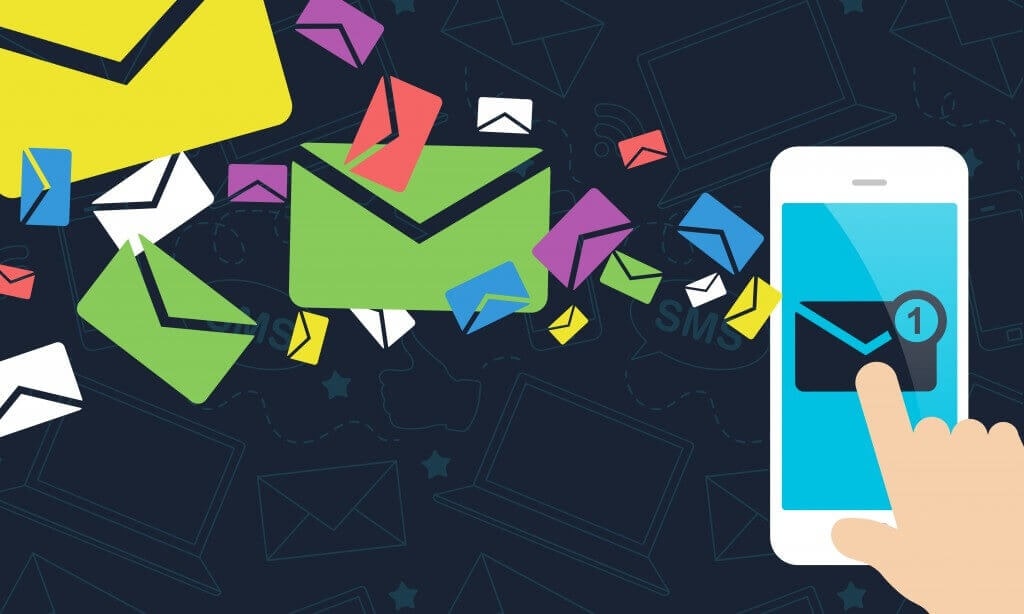
In the hospitality industry, you want to increase the number of direct bookings, promote brand engagement, and create guest loyalty. This necessitates careful targeting of the messages. Email marketing will help you with this since it is simple to automate and affordable. Here are the reasons why you need to have email marketing in your strategy if you’re in the hospitality industry.
- You Can Create Laser-Targeted Email Marketing Campaigns
- Email Marketing Offers the Highest Return on Investment for Hotels
- Email Marketing Enables Hotels to Pitch New Offers and Improve Sales
- Improve Your Services by Collecting Customer Feedback
- Email Marketing Drives Traffic to Your Website
- Email Marketing Helps Your Business Stay on Top of Your Customers’ Minds
How to Get Started with Hospitality Email Marketing
Step 1: Build Up Your Email List
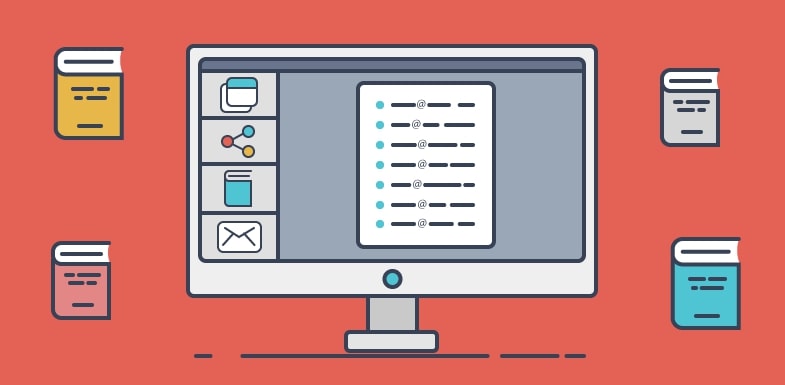
Before you can create an email marketing campaign, you need to build a list of subscribers who have signed up to receive your emails. Here’s how you can do it:
- Import email addresses from your current database. Check your CRM, booking history, or guest book for email addresses of customers you already have, and add them to your mailing list.
-
You do not give emails to someone who has not expressly agreed to accept emails from your business. If you do, you might be in violation of GDPR, CCPA, or other consumer privacy laws in your country or state.
-
It’s interesting how many hotels’ websites don’t have an email subscription form. If this describes you, email marketing tools such as AVADA Email Marketing Automation will help you build a signup form in minutes.
-
Be sure to give an incentive for your customers to sign up. Early check-in, exclusive offers and discounts, room upgrades, and maybe even a chance to win a hotel voucher are some examples.
-
Put the signup form in a prominent place on your website. To increase subscriptions, you can also use a pop-up box or an exit-intent box.
- Plan to deliver a newsletter to your subscribers on a weekly, bimonthly, or monthly basis. Gramercy Park Hotel, for example, receives newsletter subscriptions by providing members with exclusive email offers
Step 2: Segment Your Mailing List
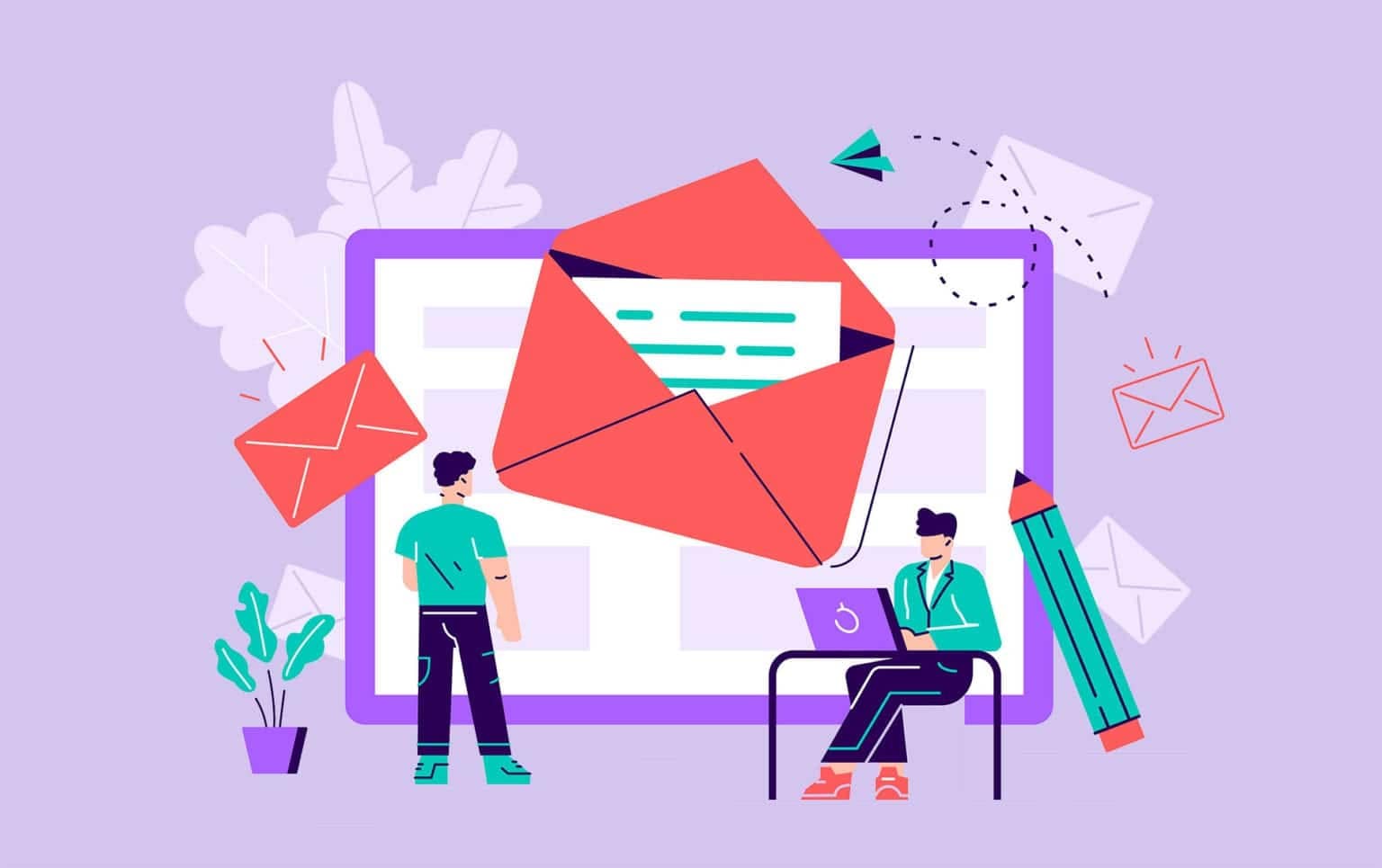
When it comes to marketing, one size does not suit everything. To get the most out of your email campaigns, you can send personalized content to each subscriber. An easy way to personalize is to include the recipient’s name in the subject line. It draws the recipient’s attention and increases the likelihood that they will open the email.
However, the name is just the beginning. A better method is to divide the mailing lists into groups of customers that have similar characteristics. Here’s how to go about it:
-
Begin with the fundamentals: age, gender, and place.
-
Customers should be segmented based on where they are along their purchasing journey. Are they collecting details, getting ready to book a reservation, or returning customers?
-
You may also segment based on previous purchases or consumer behavior if necessary. For example, you might send an email to customers who booked a room for their vacation last year with a special deal if they book again this year.
-
You can further segment the subscribers based on the type of room they reserved, the amount they spent, the channels they used, and the services they used.
Even simple segmentation is preferable to no segmentation. And if you personalize your emails, you should expect better results. Fortunately, most email management systems allow you to segment your mailing list. Simply add subscribers to a segment to begin reaching out to your customers with more personalized content.
Step 3. Set Up an Email Lead Nurturing Sequence
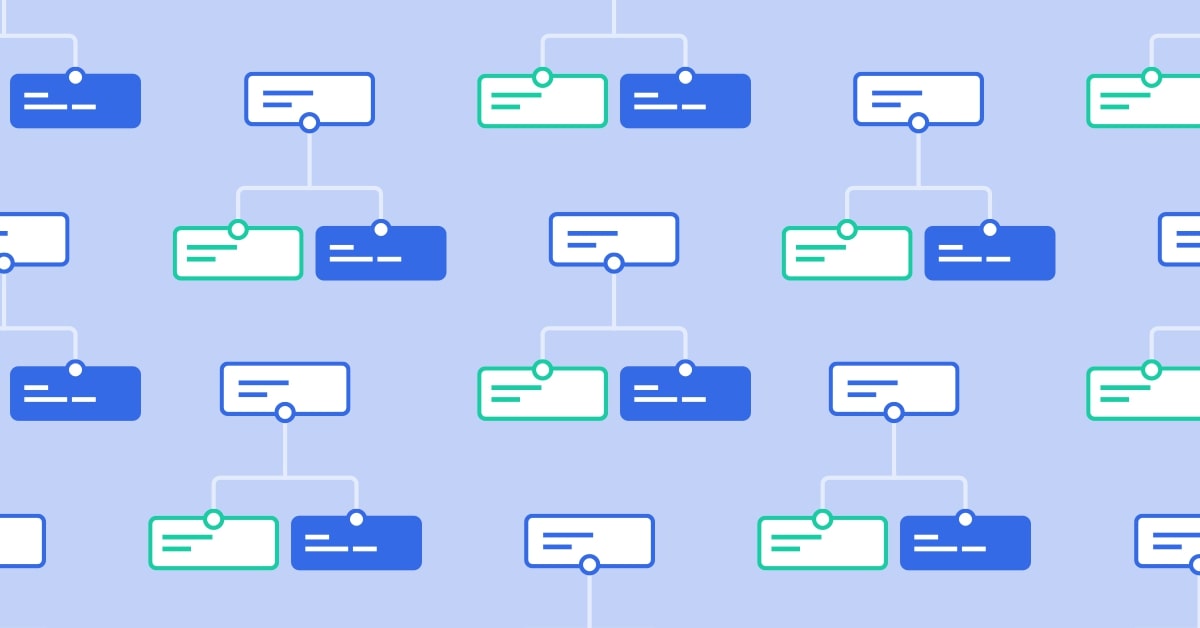
If you want to use email marketing as a tool to produce long-term results, you need to build a relationship with your audience. This is where an email nurturing series will help. A nurturing sequence is an automatic series of emails that a guest receives when they subscribe to your mailing list. It is also known as an email flow, drip campaign, or email series. Here’s how to do it:
- To prepare and automate a drip campaign, use an email marketing platform (such as AVADA Email Marketing Automation).
-
Choose the duration of the sequence. The number of emails in a series is determined by your product, service, and marketing plan. It should be at least 2-3 letters, but it can be much longer.
-
Create your welcome email, which will be the first email the subscriber receives after signing up for your mailing list.
-
According to statistics, the welcome email has the highest open rate. It is your first chance to make a good first impression.
-
Send links to your most-read blog posts, videos, and reviews to your audience to build confidence.
-
Make certain that each email in the series brings value to the reader’s life.
- Subscribing to your own mailing list will enable you to automate and test your email series.
Step 4. Follow Email Marketing Best Practices
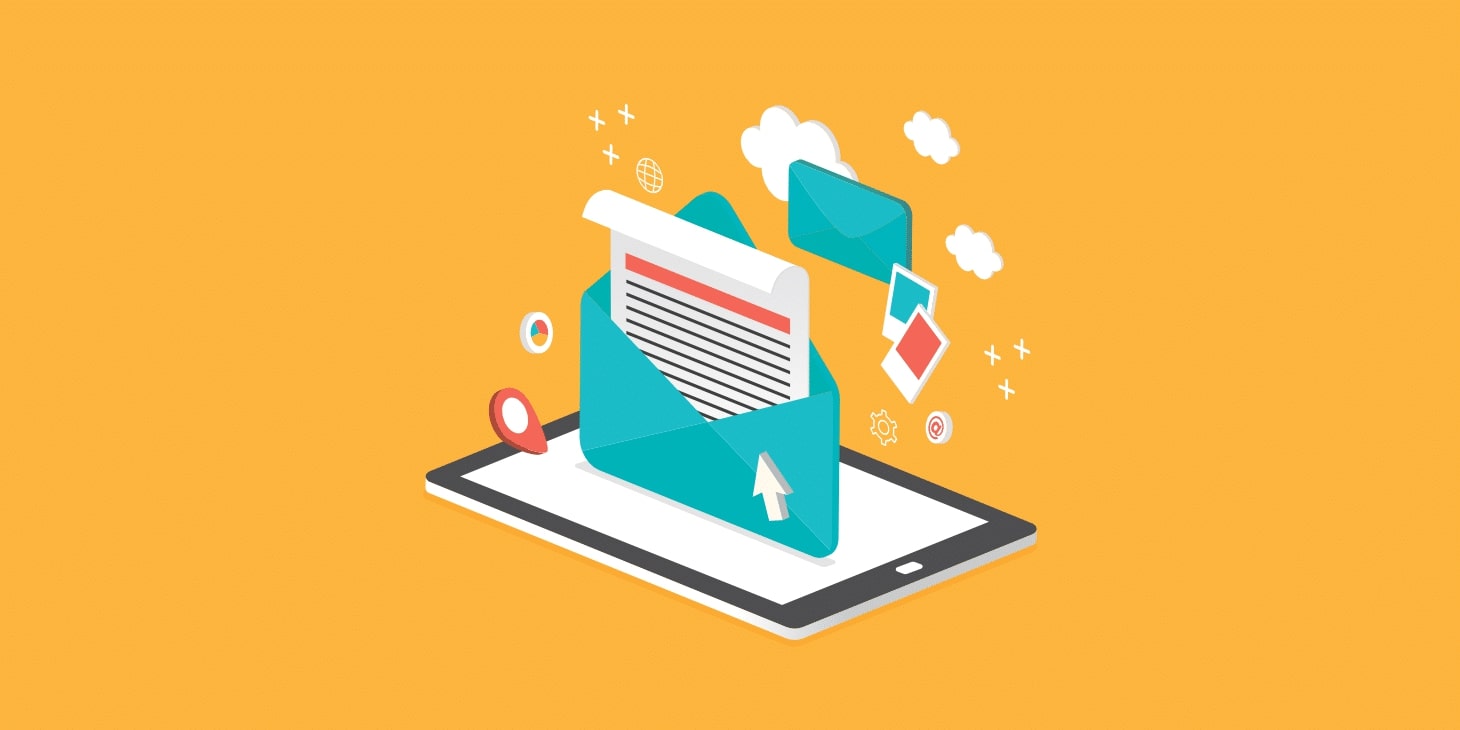
Let’s take a quick look at some tried-and-true email marketing practices that can guarantee great open rates, clicks, and conversions.
- The subject line, which is the most critical part of your text, determines the open rate entirely. Make sure your subject lines are interesting and catchy (but still relevant).
- Subject lines with the highest open rates have less than 50 characters – about 30 is ideal.
- Don’t make the subject line too complicated. Remember K.I.S.S. (Keep It Simple, Stupid).
- When creating email subject lines, keep the five main elements in mind. CURVE stands for Curiosity, Urgency, Relevancy, Value, and Emotion.
- A/B assessments are a great way to put the subject lines to the test. The majority of the most recent email marketing solutions have A/B testing capabilities.
- Emails that have the customer’s first name in the subject line have been shown to increase open rates.
- Make sure your emails are sent at the appropriate times. For example, sending a promotional offer within 24 hours of a new signup will result in substantially higher open rates than sending the same offer after a few days.
- Before you hit the send button, double-check all spellings. It is important that the spellings of the person’s name and business be correct, as well as that the field names match. You do not want to be the hotel that sends emails with the dreaded First Name in the subject line!
- NEVER USE ALL CAPS in the body or subject line of an email! If you do, many of your subscribers would unsubscribe.
Step 5. Monitor and Track Your Email Campaigns
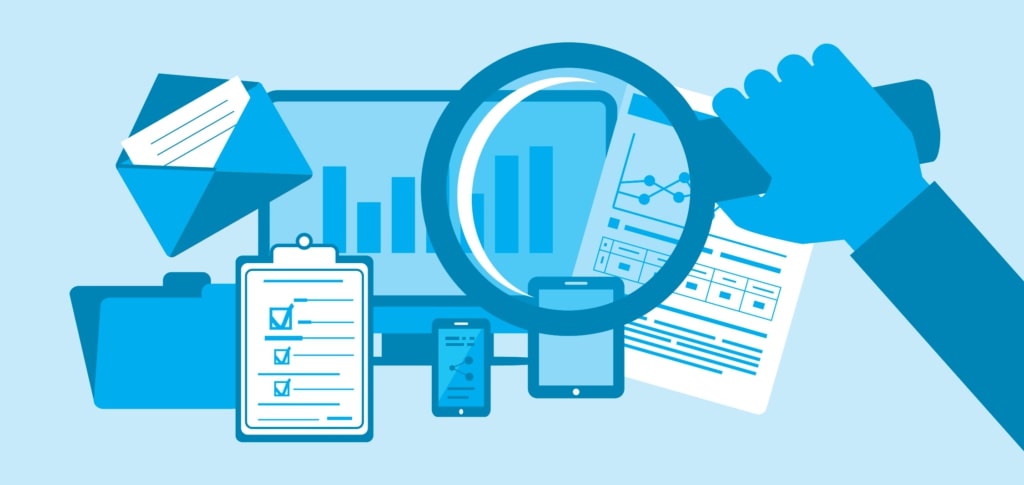
If you don’t want to waste your money, you must monitor the results of your email campaigns. These campaigns can be tracked using tools such as AVADA Email Marketing Automation. However, before you can track your campaign, you must first understand what metrics to track. Keep an eye on the metrics below to see what’s working and what’s not.
- Open rate: The percentage of recipients who click on your email is referred to as the open rate. Most email campaigns have a success rate of slightly more than 30%.
- Click-through Rate: The number of subscribers who click on the links in your email is referred to as the email click-through rate. Every email campaign should have a particular target in mind and should cultivate readers toward that goal by subtly embedding links or calls-to-action in each email.
- Conversion Rate: The conversion rate represents the number of people who complete the action that is the campaign’s target. In other words, you ‘convert’ a customer every time you achieve your campaign’s target.
- Unsubscribes: subscribers can sometimes unsubscribe from your mailing list. Perhaps they find your content insignificant or unintentionally subscribing to your mailing list. Your email client will notify you of the number of unsubscribes, which you should aim to keep to a minimum.
- Spam Complaints: Most people won’t report your emails as spam unless they are of poor quality or aggressive in sales pitching.
10 Winning Email Marketing Ideas for Hotels
Use these brilliant email marketing ideas as inspiration for your own hotel marketing emails, and you’ll see an increase in open prices, bookings, and ROI.
1. Location newsletters
A marketing email is an excellent way for hospitality businesses to notify customers that they are staying at their location, similar to a “YOU ARE HERE” moment. Use your newsletters as a map to illustrate your business’s venue, local attractions, and tours available in the surrounding area. This will add value to your hotel’s already excellent facilities and amenities, enticing guests to book.
Check out this fantastic example from Tourism NYC; it could easily be adapted and used in a marketing email for a New York City-based hotel. They added strong value to would-be visitors interested in paying a visit to the Big Apple by sharing upcoming local activities ahead of the summer vacation season.
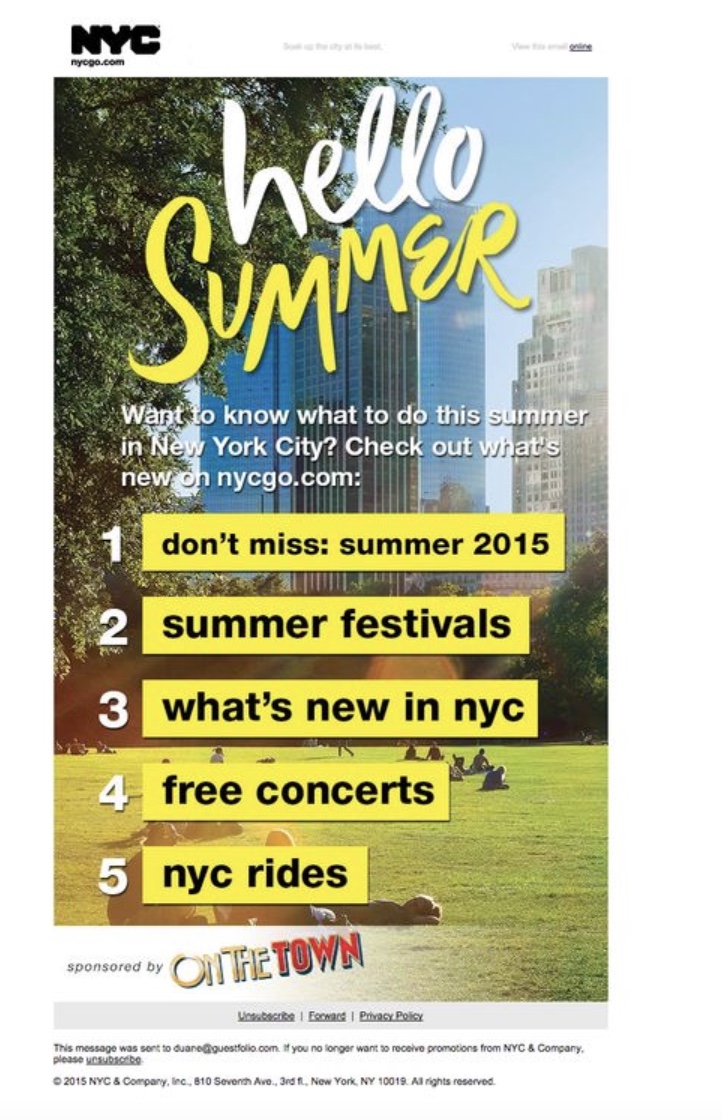
2. Culinary newsletters
Another great way to add value with email marketing is to inform your customers about the fantastic culinary experiences that await them both inside and outside your location. You can also combine this knowledge with holiday promotions. Hotel guests who have already spent a lot of money on their hotels can’t help but be delighted when they are approached with an offer that will make their travel more affordable.
That is exactly what the Shangri-La hotel in Vancouver did. Before Mother’s Day, the hotel ran a mouth-watering marketing email campaign complete with details on attending Mother’s Day brunch at the hotel, tasty-looking photographs, and the choice to reserve a table right then and there. Using their mailer as inspiration and including a section with icons and details about famous eateries in the area will help you increase hotel bookings even if the actual meal is eaten elsewhere.
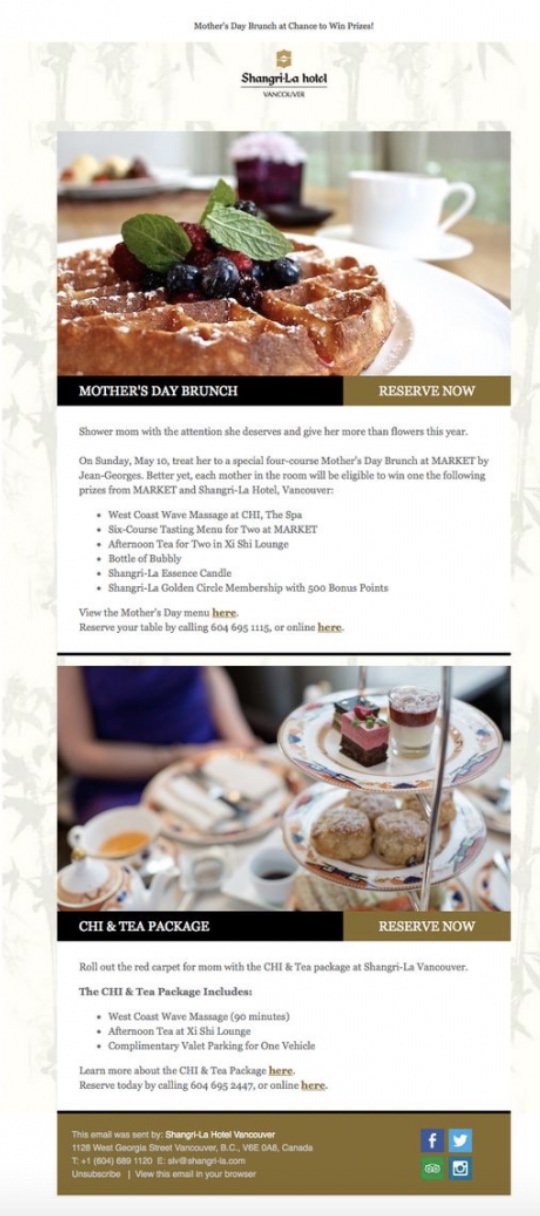
3. Special campaigns
Email marketing for hospitality is an extremely successful method of informing consumers about exclusive deals, promotions, and discounts. Sending them directly to the customer’s inbox rather than in public social or other marketing materials, and personalizing them to suit the customer’s needs wherever possible, is a surefire way to make them feel unique, as if they’re getting exclusive access to deals that no one else is.
This target was well met by the Best Western hospitality chain. Their “Deals of the Week” mailer informs consumers about the limited-time offers they will receive if they book a stay at any of their hotels around the United States. The campaign generates a sense of urgency while also giving consumers the impression that they have a range of choices to choose from at unbeatable rates.
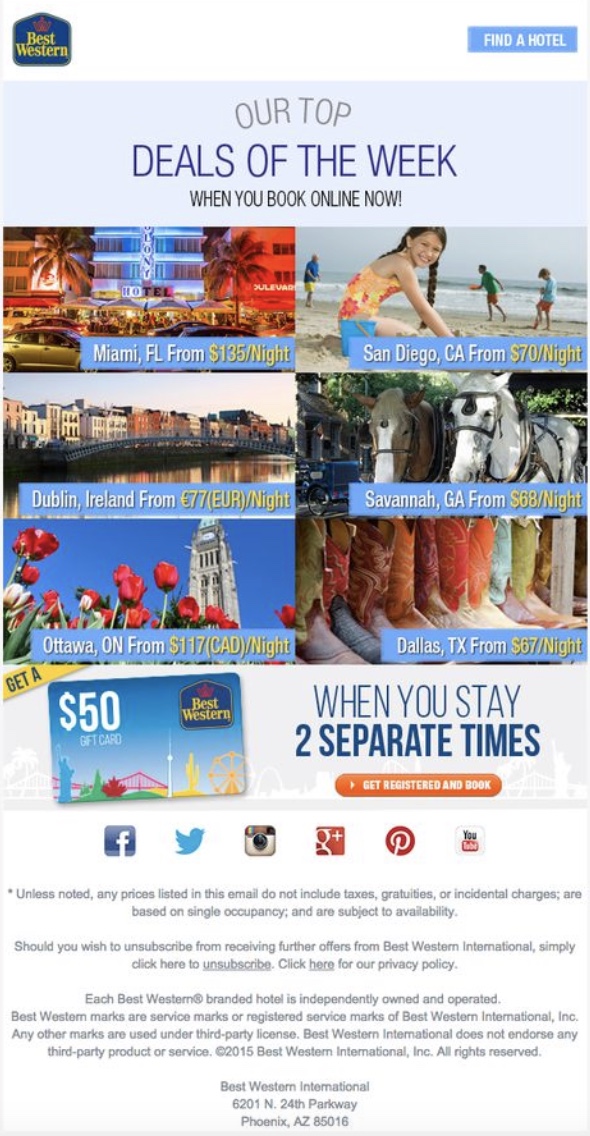
4. VIP marketing emails
It can cost five times more to acquire a new customer than it does to maintain a current one, so cultivate your best customers for retention with a VIP-inspired newsletter that keeps them coming back. In a nutshell, make them feel very special by offering an exclusive deal to loyal customers only!
Occidental Hotels & Resorts, for example, sent out the marketing email shown below. Although the mailer itself is a little wordy, the integration of thanking previous guests for their loyalty, the 10% discount in the form of a promo code, the simple call to action “Book Now,” and the welcoming picture combine to form a VIP-esque email marketing concept for hotels.
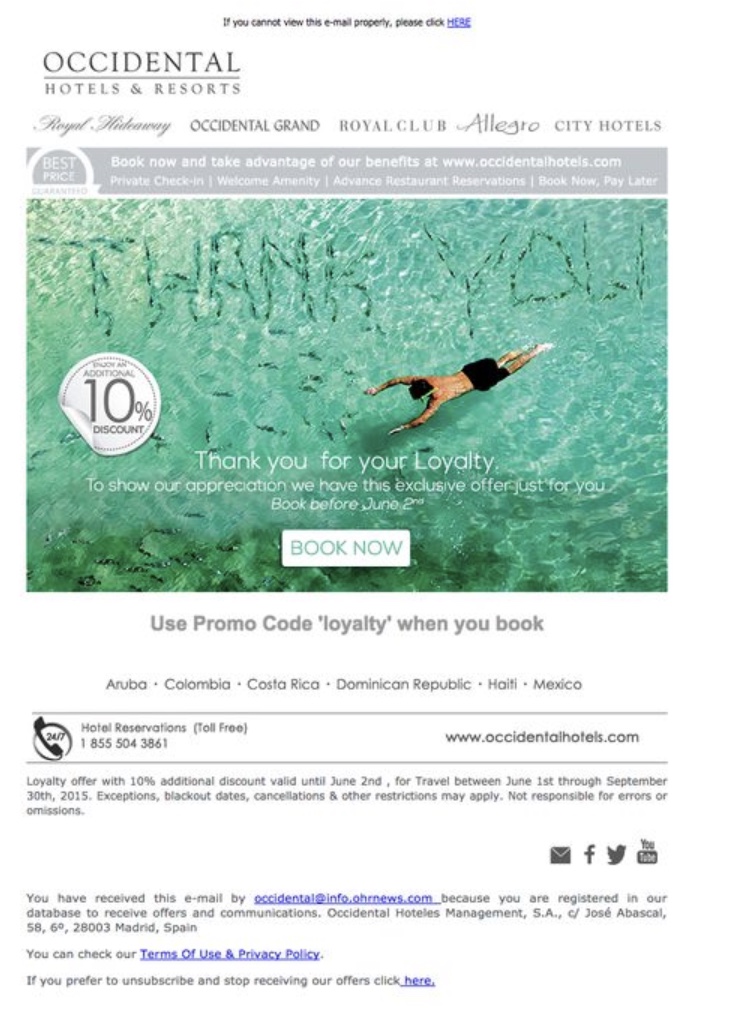
5. Cart abandonment newsletters
The hospitality industry, including hotel reservations, has one of the highest cart abandonment rates in the world of e-commerce. On average, prospective travelers abandon hotel and online travel websites just minutes before booking, compared to 68-74 percent abandonment rates in other industries.
In order to resurrect the abandoned deal and lead to a profitable booking, a winning email marketing concept for hotels is critical. Send them an offer, coupon code, or a discount on the reservation itself, or on an in-house extra like a room service, spa treatment, or a meal in your hotel’s restaurant.
6. Follow-up marketing email ideas
Following up with current hotel guests soon after their most recent stay is critical to keeping them. In a marketing email, ask them how their stay at your hotel went. Use the ActiveTrail online survey tool to get quick feedback about what they enjoyed and hated about their holiday, so you can come up with potential email marketing ideas and give them mailers tailored to their hospitality needs and desires.
See how The Inn at Union Square achieved this objective. They invited visitors to “Tell us about your stay,” told them of their importance to the hotel, and asked them to participate in a survey. There are no bells and whistles here, but this is a highly successful email marketing concept for hospitality.
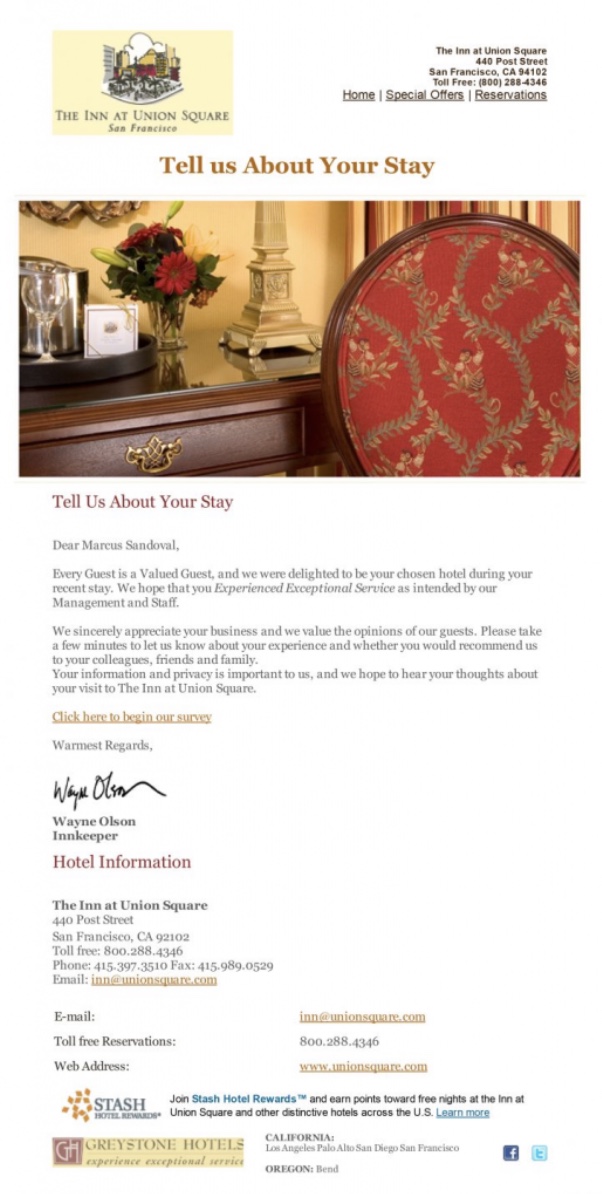
7. Testimonials
Recommendations from happy customers are a strong email marketing asset that the hospitality industry will certainly profit from, as 83 percent of people are more likely to buy a product or book a service after hearing about it from other customers. As a result, effective hotel email marketing involves sharing what your guests have to tell – with your subscribers who have yet to make a booking.
8. Visual content
Often it’s as easy as incorporating stunning visuals to catch customers’ attention and entice them to book. Since people remember 80% of what they see and just 20% of what they read, the photos and videos you use in your newsletter will turn your email marketing campaign from annoying to inspiring.
In its marketing newsletters, the Rosewood Beijing makes extensive use of modern videos to draw customers. The video takes potential guests on a tour of the hotel, familiarizing them with the location so that booking a stay no longer feels alien and distant.

9. Email marketing for hotels meets social media
Social media is now where your target audience members spend an average of two and a halfaverage of two and a half hours every day – and in today’s day and age, they’re turning to social media influencers to find out all kinds of stuff, like where they should stay on their next vacation. Collaboration with social media influencers and inclusion of their content in your hotel’s newsletters can help you generate buzz, increase open rates, and encourage bookings like a true hospitality industry winner.
Incorporating a picture like the one below into your hotel newsletter, for example, will pique your customers’ attention and encourage them to read more and book. After all, what new, digitally savvy traveler doesn’t want to post a vacation photo worthy of Instagram? Having an influencer at your hotel is a great traffic-generating idea that you can certainly implement.

10. Event promotion
Use email marketing to inform consumers of the types of events that have taken place or will take place at your business, such as concerts, weddings, conferences, and other fun things they won’t want to skip.
Pro tip: Use emotional words to explain the incidents. Tempt them with the prospect of joining in the fun – “you could be here.”
Outrigger Resorts used effective hotel email marketing by sandwiching event promotion between a call to book and details on local attractions – complete with stunning photographs.
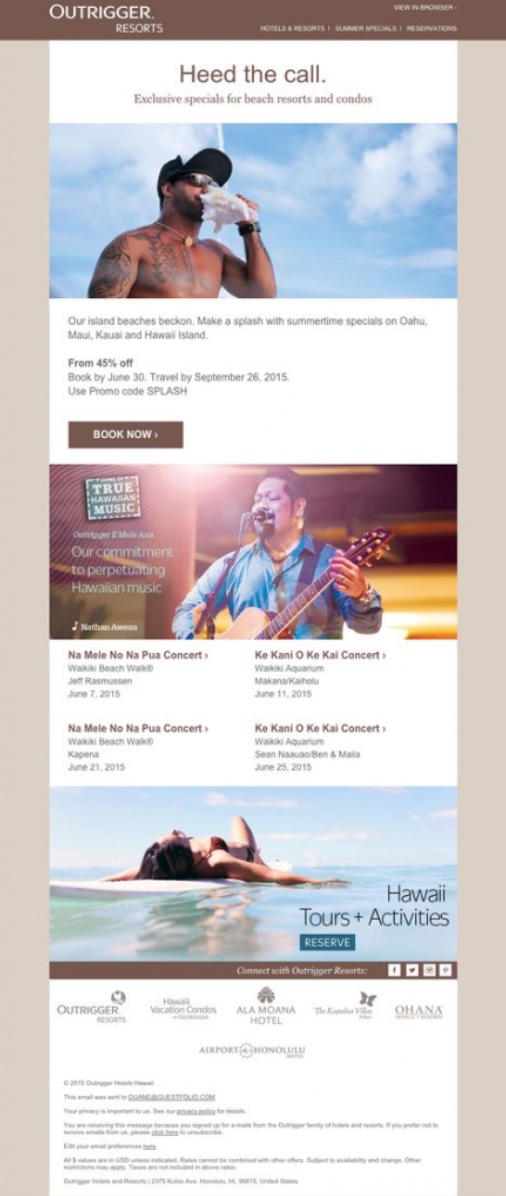
Final words
That’s it! I hope that this article has given you valuable knowledge about how to get started with email marketing for hospitality. Please feel free to leave comments below for further discussion on this topic!
New Posts






